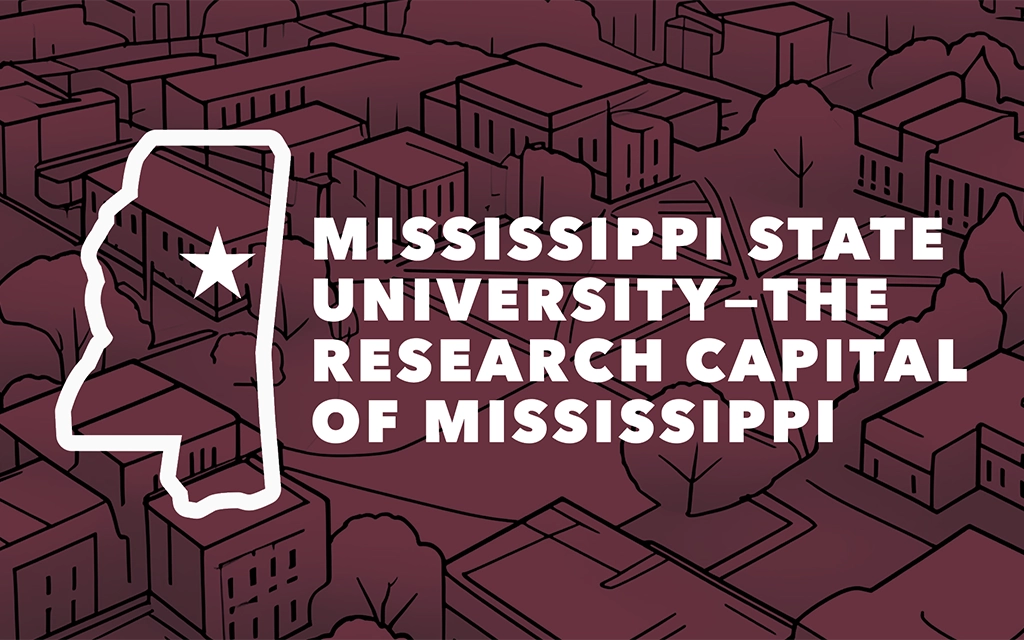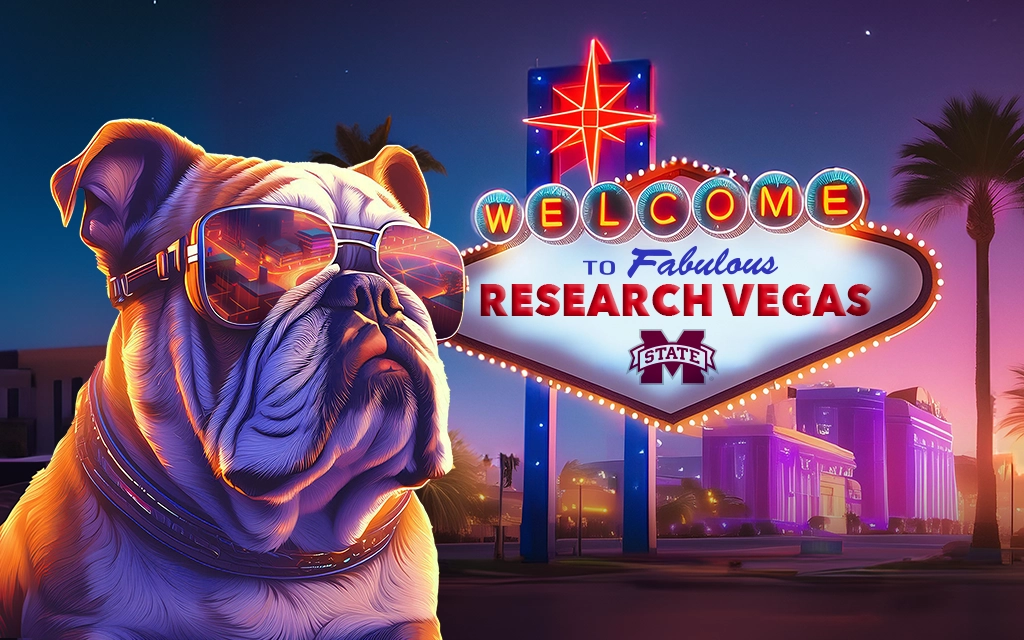Viva ResearchVegas, Bulldogs!
What happens in Starkville, doesn’t stay in Starkville. It changes the world.
“We have scores of people from all over the country—really, the world—who visit MSU. When we show them our capabilities and how we share what we do, it changes their perception of Mississippi,” explained Julie Jordan, MSU’s vice president for research and economic development. “When companies and agencies realize what we’re capable of and the ways we innovate, they want to be in business with Mississippi and MSU.”
As head of Mississippi State’s research activities, Jordan supports more than 4,000 Bulldogs—equal to the population of many small Southern towns. Together, this group, which only includes MSU faculty, staff and students engaged in the research sector, was responsible for directly putting more than $319.7 million into the economy during fiscal year 2023.
Put into context, it is more than a 5% increase over the FY 2022 number that ranked Mississippi State in the National Science Foundation’s Top 100 research universities. It also accounted for more than half of the $565.3 million spent by Mississippi universities for research and development. And while the national FY 2023 reports and rankings for higher education R&D expenditures will not be available until later this year, Jordan is already proud of the university’s impact.
“This is the most Mississippi State has ever reported for R&D expenditures, and we lead all of the universities in the state,” Jordan said. “But what’s important here isn’t just that we’re reporting our largest ever research spending—it’s what we’re spending it on.
“We’re not just doing projects to gain prestige,” she continued. “We’re working to solve problems, and we’re putting those innovations out into the world to make businesses more profitable and keep jobs in Mississippi.”
A Catalyst for Economic Growth
Like any economic hub, the impact of ResearchVegas doesn’t stop at the university’s borders—it branches out to help raise the profile of the entire region.
Beyond MSU’s direct spending on R&D, there’s a ripple effect. For example, the university’s 4,000 research-related employees mean more people in Starkville purchasing goods and services. And much like Bulldog sporting events bring tourist dollars to StarkVegas during home games, ResearchVegas helps fill hotels, restaurants and stores with conference attendees, visiting scholars, funding agency representatives, and current and future MSU faculty, staff and students.
The ripples continue as ResearchVegas’ students disperse into the region as interns and cooperative education employees ready to use their knowledge and problem-solving skills to address real-world challenges. These students then become graduates who become a highly sought after workforce for highly sought after, competitive jobs.
Joey Deason, executive director of the Madison County Economic Development Authority, said access to these top-tier minds is one of the ways proximity to MSU helps recruit new industry to the Magnolia State.

“When we’re recruiting industry, we’re looking to create jobs and an investment for the community,” Deason said. “And it’s not just any jobs, we’re looking to bring in business that will create jobs that pay more than the average Madison County wage is today. That means we’re looking to recruit those companies that will pay above $26 per hour.”
Deason explained the presence of MSU and the university’s reputation as a scientific leader helps reassure those companies that they will be able to fill those high paying jobs if they locate to Mississippi. He pointed to the game-changing arrival of Nissan in the early 2000s and the recently announced $10 billion Amazon Web Services data center as examples of how Mississippi State contributes to securing new business.
He cited the university’s Center for Advanced Vehicular Systems as a key component of attracting both Nissan to Madison County and Toyota to Blue Springs. The arrival of the former helped cement Mississippi State as a leader in applied research when the Mississippi Legislature and the university created CAVS-Extension in Canton, a ready-made resource for addressing issues that arise in manufacturing and product development.
Similarly, the Amazon Web Services investment—which is more than four times the size of the previous largest capital investment in Mississippi—will help MSU become one of the South’s go-to universities for technological advancement.
“AWS understands the value of partnering with universities and our ability to provide a well-educated, technical workforce,” Jordan said. “This proves that the kinds of companies we are attracting, and will continue to attract in the future, are high tech. And in preparing the high-tech workforce for the future, we will expand our capabilities and research in these areas, which will not only help these new arrivals but existing Mississippi businesses as well.”

‘Future Proofing’ the Economy
Considering economic indicators, developments in technology and what types of research are being supported globally, Jordan said it’s easy to see that the jobs of the future will be more and more technical—and that will affect how everyone operates.
“How we apply technologies like artificial intelligence, automation and robotics will change almost every business, in every sector, over the next 20-30 years,” Jordan explained. “The university is positioned to be a leader in that. With the work that we do, we can increase the competitiveness of our state, create new opportunities for our citizens, and help existing business and industry to be more successful.”
Jordan calls it “future proofing”—helping small and medium enterprises embrace emerging technologies to make their operations more efficient, resilient and competitive with larger businesses that traditionally adapt more quickly to a changing marketplace.
Jordan said she remembers when the South’s economy was rocked due to a failure to evolve with the changing economic climate. It’s something she thinks MSU can help today’s manufacturers avoid in the future.
“I’m old enough to remember when the industry that supported most small, Southern towns was textiles,” Jordan explained. “Our economy ran on cut-and-sew, so when those plants shut down, those people lost their jobs and the buildings sat empty. It was a huge loss to those communities.”

Today, she said, Mississippi has approximately 1,500 companies that self-identify as manufacturers. Many have fewer than 100 employees but are the backbone of their rural communities. Jordan said it’s essential to protect those jobs, which are very important not just to the employees but also their families and the communities in which they live.
“A lot of these businesses are still doing things by hand the way they were when they started 30, 40 or 50 years ago. But within those industries—almost all industries—automation is changing things,” Jordan continued. “If these companies want to remain competitive, they’ve got to automate. And using our research and our researchers, we can help them find ways to use these emerging technologies to be more efficient and remain competitive.”
Mississippi State’s “future-proofing” research efforts start with developing new technologies and exploring new uses for emerging technology in applied settings. This crosses many academic disciplines, involves numerous research centers and includes building artificial intelligence platforms, advances in autonomous machines and vehicles, and performance enhancing products and methods meant to improve worker safety and productivity.
These research projects receive funding from state and federal agencies, as well as grants from organizations and private enterprises. The work results in peer-reviewed academic publications and conference presentations, which can earn researchers additional funding for future projects. And while these academic results are great, they’re not easily accessible to everybody. That’s why Mississippi State has partnerships with area industry and reaches out to incoming businesses to help them make sense of and apply these cutting-edge advances.
Tonya McCall said CAVS-E, which is part of the Mississippi Manufacturers Association Manufacturing Extension Partnership, helps connect companies with MSU resources that can support their enterprise. That can mean identifying scientists who can find solutions to a production problem, providing workforce training, or helping implement new, best practices for improved resource management.
“We work with manufacturers of all sizes who are interested in making improvements to their operations,” explained McCall, who is director of CAVS-E. “We provide pragmatic solutions to issues they are facing, bridge communication between our industry partners and academic partners, and assist with the implementation of new manufacturing processes.”
ABB Motors and Mechanical Inc.’s Columbus facility is one of dozens of groups that partner with CAVS-E each year. Formerly known as Baldor Electric Co., ABB manufactures electric motors and sought the university’s expertise in smart connectivity and ways to use ergonomics to improve the on-job experience of its 300 employees.
While the company can’t publicly release specific outcomes, operations site manager Suzanne Mitchell said the work with MSU has improved efficiency and employee satisfaction within the facility. The partnership has also helped ABB find new employees.
“There are students working on our projects at MSU as undergraduates and we’re able to hire them once they graduate,” Mitchell said. “They’re able to walk in the door, know what we do and get started.”
McCall said having these relationships with businesses in Mississippi is at the heart of the center’s mission. Since its creation, CAVS-E has had an estimated $7 billion impact on the state’s economy, including helping to create or retain more than 7,000 jobs.
“In everything we do, our focus is helping Mississippi businesses be successful and competitive,” she added.

Betting on the Farm (and Forest)
Industrial manufacturers aren’t the only ones who benefit from access to ResearchVegas. The state’s agricultural and forestry industries also reap big rewards, with MSU-based science as their ace in the hole.
Keith Coble, vice president for MSU’s Division of Agriculture, Forestry and Veterinary Medicine, explained that the Magnolia State’s agriculture and forestry industries are responsible for adding more than $16 billion to the Mississippi economy annually. So, when it comes to the success of producers in the state, they’re not betting the farm—they’re betting on the farm’s ability to bring financial stability to the table.
“Agriculture and forestry are a big part of the Mississippi economy,” Coble said. “It is responsible for more than 18% of the state’s economic activity and affects the daily life of almost every Mississippian, from the people employed directly by farms, foresters and processing facilities to the people who consume the goods and products they produce.”
As an example, Coble points to the university’s research in avian influenza, commonly called bird flu. Carried by wild fliers, the virus can infect the flocks on poultry farms leading to sickness and death among the livestock. This ultimately impacts not only the bottom line of poultry producers but also leads to scarcity and higher prices for both meat and eggs at the grocery store.
Recognizing the impact of such diseases, scientists in MSU’s Department of Poultry Science and College of Veterinary Medicine worked to find ways to aid poultry farms in protecting their flocks. Mark Leggett, president of the Mississippi Poultry Association, said these efforts were imperative in the continued success of the state’s 1,430 poultry farms, which employ more than 25,000 people.
“MSU’s faculty and staff are involved in educating both poultry companies and growers about the best research-based practices,” Leggett said. “The testing done by the College of Veterinary Medicine is a key factor in identifying poultry diseases to quickly prevent their spread.”

Coble said that is just one example of MSU’s research-based impact on the state’s commodities, from the fields to the ponds to the forests.
Mississippi’s soybean industry continues to benefit to the tune of more than $1 billion annually thanks in part to the late 1990s intervention of MSU scientists that changed the way soybeans were grown in the Magnolia State. The science developed at MSU, which was then shared with growers by MSU Extension Services, turned a low-yield, economically risky crop into an annual $1.5 billion economic driver.
“We do very applied research as part of our land-grant model, and then we disseminate it to the people of the state,” Coble explained. “That’s what makes the partnership we have between our researchers and Extension faculty and staff unique. We do the research, then our Extension partners make it available to the people who can benefit from it.”
Bulldog researchers have developed vaccination technology to protect the state’s farm-raised catfish from a commonly occurring bacteria that was wiping out whole ponds. And a new MSU-developed production system has more than doubled catfish production in the Delta.
Meanwhile, MSU faculty-developed Mill Site software is improving productivity in the wood products industry by identifying the best locations for processing facilities. Weighing factors including raw materials, transportation, utilities and labor, the software can in minutes provide the decision-making insights it would take days to compile by hand. This helps economic developers in the state know when their municipality would be a good fit for a company and produce incentive packages to help draw new business to the area.
“The Mill Site software is an excellent addition to our economic development toolbox that has helped attract new forestry manufacturers to Mississippi,” explained Casey Anderson, executive director of the Mississippi Forestry Association. “We are confident this technology will help us recruit even more manufacturers to our state in years to come.”
Yes, there’s something for everyone in ResearchVegas, the South’s scientific playground, where MSU is investing in the future and letting it ride.
“At MSU, we support our research because our research supports the state,” Jordan said. “It’s part of our mission as a land-grant university and a good steward of the public’s investment. We’re here to raise the profile of our state and our people and secure a better future for tomorrow.”
Story by Susan Lassetter; Bulldog art is a blend of multiple Adobe Firefly AI-generated images, along with layers of additional typography and digital illustration elements by Heather Rowe

Before a university can put money into the economy in the form of research expenditures, it must first secure financial investments to support that work.
Mississippi State leads all eight members of the Mississippi Institutions of Higher Learning in bringing research dollars into the state.


